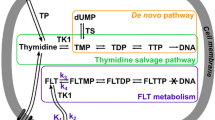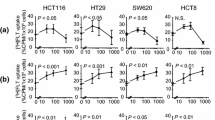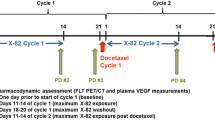Abstract.
This study evaluated the use of 3′-deoxy-3′-[18F]fluorothymidine ([18F]FLT) for monitoring of the early effects of anticancer chemotherapy on tumour cell proliferation. Cells derived from human oesophageal squamous cell carcinoma (OSC-1) were grown for 2 days and incubated with cisplatin (CDDP), 5-fluorouracil (5-FU), methotrexate (MTX) or gemcitabine (GEM) for 4 h. Cultures were incubated with drug doses (CDDP: 0.67, 6.7, 67 µM; 5-FU 15.4, 154, 1,540 µM; MTX: 4.4, 44, 440 µM; GEM: 0.0067, 0.067, 0.67 µM) corresponding to approximately 10%–95% proliferation inhibition (MTX: 10%–75%). Treatment was stopped and cells were allowed to recover for 4, 24 or 72 h. [18F]FLT was added for 10–180 min. Control cultures were incubated with [18F]fluorodeoxyglucose (FDG). Cell counts, viability, clonogenic activity and cell cycle distribution estimated by flow cytometry were used to evaluate the cytotoxic effects of chemotherapy. Strikingly, FLT uptake per 105 viable cells was increased seven- to tenfold 24 h after treatment with 5-FU or MTX irrespective of dose. Thus, total FLT uptake per tissue culture exceeded that of controls despite a considerable decrease in overall cell counts due to cytostasis up to 72 h after treatment. 5-FU-treated cells showed accumulation in early S phase (overall S phase: 88% vs 42%). GEM treatment resulted in a more moderate increase in total FLT accumulation, to a maximum of fivefold at the dose close to the IC50. In contrast, FLT accumulation was significantly reduced at cytostatic concentrations of CDDP and was still decreasing in a dose-related manner at 72 h despite considerable S phase arrest. With 5-FU or CDDP, the uptake of FDG did not differ significantly from control values 24 h after treatment. These findings demonstrate that tumour cell uptake of FLT – in contrast to that of FDG – reveals specific changes depending on the cytostatic drug used for treatment. The antimetabolites 5-FU and MTX massively increase FLT accumulation per cell independent of dose, i.e. cytotoxicity. Early after treatment, this increase is not predictive of proliferation inhibition but reflects activated salvage pathway of DNA synthesis. By contrast, CDDP results in an early decline in FLT but not in FDG uptake. This drug-specific modulation of FLT uptake has to be taken into account in positron emission tomography studies using FLT for treatment monitoring.
Similar content being viewed by others
Author information
Authors and Affiliations
Additional information
Electronic Publication
Rights and permissions
About this article
Cite this article
Dittmann, H., Dohmen, B., Kehlbach, R. et al. Early changes in [18F]FLT uptake after chemotherapy: an experimental study. Eur J Nucl Med 29, 1462–1469 (2002). https://doi.org/10.1007/s00259-002-0925-z
Received:
Accepted:
Issue Date:
DOI: https://doi.org/10.1007/s00259-002-0925-z




